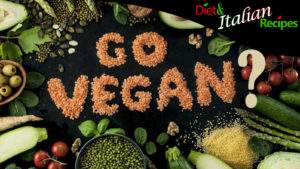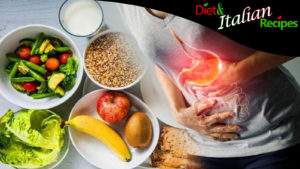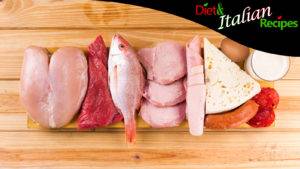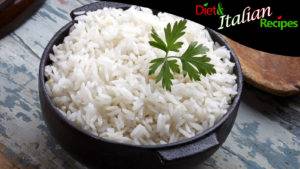A balanced vegetarian diet is based on reduced consumption of animal-derived foods and the total absence of animal-derived foods in the diet. Below you will find a weekly menu for a balanced vegetarian diet, what vegetarians eat, the origins of the vegetarian movement, and useful insights to start this diet. Following a vegetarian diet can be risky for those who do not pay attention to preventing possible nutritional deficiencies, otherwise it is a safe diet. The balanced vegetarian diet that we present with an example of a lacto-ovo-vegetarian weekly menu is simple and can be tried by everyone without risks.

Basics of the Vegetarian Diet
Balanced Vegetarian Diet – Example with Weekly Menu – Starting a vegetarian diet is always a happy choice, especially because we know that the choice not to eat meat is partly due to health reasons and partly to respect for other animal species.
The basis of the vegetarian movement in Europe, the Vegetarian Society, founded in England in 1908, is based on solid ethical and health principles. So much so that the vegetarian movement was born in opposition to European colonialism accused of exploiting men, but above all animals, only to feed waste and luxury.
However, vegetarians already existed in Asia, where the main religious and philosophical disciplines – Hinduism, Buddhism, and Taoism – lead to not consuming meat. It is no coincidence that the country with the highest number of vegetarians in the world is India, the birthplace of Hinduism.
Balanced Vegetarian Diet: What do Vegetarians Eat?
Balanced Vegetarian Diet – Example with Weekly Menu – What do vegetarians eat? All vegetarians do not eat meat, the rest of the food they consume depends on the type of vegetarian we are talking about. According to the food pyramid, a balanced daily vegetarian diet should include 6 servings of cereals, 5 servings of legumes and nuts, 4 servings of vegetables, 2 servings of fruit, and two of fats.
Types of Vegetarian Diet
Balanced Vegetarian Diet – Example with Weekly Menu – We know that today there are several types of vegetarians who eat totally different things:
- “Lacto-ovo-vegetarian” is the most common form of vegetarian diet, and it is also the most balanced and well-rounded. This type of vegetarian diet is the most tolerant but does not allow the consumption of foods such as meat (neither red nor white) and fish (not even mollusks and crustaceans). From the name “lacto-ovo,” one can understand that they can eat eggs, honey, and accept to drink milk of animal origin and eat dairy products.
- “Lacto-vegetarian” is the most practiced diet in Asia, and the only difference from the “lacto-ovo-vegetarian” diet is that in this case, eggs are also not allowed.
- On the contrary, in the “ovo-vegetarian” diet, the consumption of milk and dairy products is not allowed, but the consumption of eggs is allowed.
- Then there are the “vegans,” who do not eat meat, fish, dairy products, or eggs; vegans do not even eat honey. It is an even stricter form of diet but which allows seaweed and mushrooms in good quantities to assimilate essential vitamins such as vitamin B12.
- we can also mention the “raw vegan diet” and fruitarianism. The latter type of diet is based on the principle that fruit is the elective food for humans, while plants must not be damaged or exploited in any way because they too are living beings. Fruitarians eat only ripe fruit, dried fruit, and vegetables such as zucchini, peppers, cucumbers, and tomatoes, as they are fruits of plants.
Example of a balanced vegetarian diet with a typical weekly menu
Balanced vegetarian diet example with weekly menu – In order to give you the opportunity to try a vegetarian diet, a “lacto-ovo-vegetarian” type of diet, which is tolerant but still attentive to animals, here is an example. Below is a typical weekly menu for a balanced vegetarian diet that you can start immediately and without risk, as agreed by the nutritionist Luca Piretta. When interviewed by Melarossa, the nutritionist Luca Piretta says: “You can also start a vegetarian diet radically without any side effects, especially in the case of a lacto-ovo-vegetarian diet – which is the type of diet we are talking about today. However, you must be careful over the long term to take all the vitamins and minerals necessary to stay healthy, also using dietary supplements if necessary.”
WEEKLY MENU – BALANCED VEGETARIAN DIET
Balanced vegetarian diet example with weekly menu – This example of a balanced vegetarian diet with a weekly menu was presented with 5 daily meals, but this is a detail that needs to be customized according to your needs.
Balanced Vegetarian Diet Example – Monday Weekly Menu
- BREAKFAST: 1 seasonal fruit (8.8 oz or 250 g) + 1 low-fat yogurt (4.2 fl oz or 125 ml) + 5 almonds + 1 green tea or espresso coffee.
- MORNING SNACK: 0.9 oz (25 g) whole grain bread + 1 boiled egg + 1.1 oz (30 g) avocado + 0.35 oz (10 g) lupin mayonnaise.
- LUNCH: 2.5 oz (70 g) pasta of choice + 3.5 oz (100 g) tomato sauce seasoned with oregano, salt, and 1 tbsp of extra-virgin olive oil.
- AFTERNOON SNACK: 1 seasonal fruit (8.8 oz or 250 g) + 3 biscuits + 1 herbal tea.
- DINNER: 4.9 oz (140 g) curry tempeh + 1.8 oz (50 g) boiled potatoes and 3.5 oz (100 g) green beans seasoned with spices and 1 tbsp of extra-virgin olive oil.
Balanced Vegetarian Diet Example – Tuesday Weekly Menu
- BREAKFAST: 1 seasonal fruit (8.8 oz or 250 g) + 1 cup of milk (8.5 fl oz or 250 ml) + 2 walnuts + 1.05 oz (30 g) of cereals.
- MORNING SNACK: 0.9 oz (25 g) rye bread + 0.5 oz (15 g) jam + 6.8 fl oz (200 ml) of juice of choice (orange, pomegranate, grapefruit).
- LUNCH: 2.5 oz (70 g) mushroom risotto seasoned with parsley, salt, and extra-virgin olive oil.
- AFTERNOON SNACK: a handful of raisins and peanuts + 1 herbal tea.
- DINNER: 7 oz (200 g) chickpea farinata + Fennel and orange salad seasoned with oil and salt.
Balanced Vegetarian Diet Example – Wednesday Weekly Menu
- BREAKFAST: 1 seasonal fruit (8.8 oz or 250 g) + 1 low-fat yogurt (4.2 fl oz or 125 ml) + 1 tsp of chia seeds + 1 green tea or espresso coffee.
- MORNING SNACK: 1 slice of margherita pizza.
- LUNCH: 2.5 oz (70 g) quinoa + 7.1 oz (200 g) zucchini sautéed in a pan with oil, spices, and salt + green salad.
- AFTERNOON SNACK: 1 tea + 4 whole wheat biscuits.
- DINNER: 4.4 oz (125 g) buffalo mozzarella + 1.8 oz (50 g) white bread.
Example of a balanced vegetarian diet – Thursday’s weekly menu
- BREAKFAST: 1 seasonal fruit (8.8 oz) + 1 low-fat yogurt (4.2 oz) + 0.5 oz puffed spelt + 1 green tea or espresso coffee.
- MORNING SNACK: 0.9 oz wholemeal bread + 1 hard-boiled egg + sliced tomato.
- LUNCH: 2.5 oz pasta of choice + 3.5 oz tomato sauce seasoned with oregano, salt, and a tablespoon of extra virgin olive oil.
- AFTERNOON SNACK: 8.5 fl oz juice with seasonal fruit + 3 walnuts.
- DINNER: 4.9 oz grilled tofu + mixed grilled vegetables seasoned with spices and a tablespoon of extra virgin olive oil.
Example of a balanced vegetarian diet – Friday’s weekly menu
- BREAKFAST: 1 seasonal fruit (8.8 oz) + 6.7 fl oz milk + 3 wholemeal cookies + 1 green tea or espresso coffee.
- MORNING SNACK: 2 medium-sized oranges.
- LUNCH: 2.5 oz orecchiette + turnip greens seasoned with extra virgin olive oil and salt.
- DINNER: Vegetarian pizza on the plate.
Example of a balanced vegetarian diet – Saturday’s weekly menu
- BREAKFAST: 1 seasonal fruit (8.8 oz) + 1 low-fat yogurt (4.2 oz) + 0.5 oz cereals + 1 green tea or espresso coffee.
- MORNING SNACK: 0.9 oz wholemeal bread + 1 slice of tempeh cold cuts.
- LUNCH: 2.5 oz pasta of choice + 1.4 oz Genovese pesto.
- AFTERNOON SNACK: 1 seasonal fruit (8.8 oz) + 1 slice of wholemeal biscuit with a layer of jam.
- DINNER: 4.9 oz soy burger + boiled cauliflower salad.
Example of a balanced vegetarian diet – Sunday’s weekly menu
- BREAKFAST: 1 seasonal fruit (8.8 oz) + 4 walnuts + 1 green tea or espresso coffee.
- MORNING SNACK: 0.9 oz wholemeal bread + 0.3 oz peanut butter.
- LUNCH: 2.5 oz pasta of choice + 3.5 oz lentils seasoned with spices, salt, and a tablespoon of extra virgin olive oil.
- AFTERNOON SNACK: 1 seasonal fruit (8.8 oz) + 1 herbal tea.
- DINNER: 3 spinach and quinoa vegetable balls + julienne carrots seasoned with balsamic vinegar, extra virgin olive oil, and salt.
Balanced Vegetarian Diet Example with Weekly Menu – This example weekly menu for a balanced vegetarian diet was written by us, not a nutritionist, therefore it is only useful to provide an idea of what vegetarians can eat even without going on a diet.
Balanced Vegetarian Diet: What deficiencies does a vegetarian develop?
Balanced Vegetarian Diet Example with Weekly Menu – Nutritional deficiencies are due to poorly managed nutrition, regardless of the type of diet. In fact, even those who eat meat and fish can experience nutritional deficiencies. Let’s see in detail which nutritional deficiencies a vegetarian who does not follow a balanced and well-rounded vegetarian diet can develop.
Vegetarians and Iron Deficiency
Balanced Vegetarian Diet Example with Weekly Menu – The most common nutritional deficiency in vegetarians is iron deficiency which is found largely in meat, especially red meat. How can vegetarians get iron with their diet? Well, there’s no need to eat a rare steak, quite the opposite. A vegetarian with iron deficiency can assimilate this mineral by regularly consuming the following iron-rich foods from the plant world: whole grains, legumes, nuts, and leafy vegetables. In extreme cases, vegetarians may need to take iron supplements.
Vegetarians and Protein
Balanced Vegetarian Diet Example with Weekly Menu – How to get protein with a vegetarian diet is another interesting question that finds a quick answer: proteins are present in large quantities in the foods of a balanced vegetarian diet. A vegetarian who eats dairy and eggs, for example, does not even have this problem. In fact, they assimilate plant-based proteins in large quantities from legumes, cereals, and nuts, and animal proteins from milk, dairy products, and eggs. For example, egg white is a food so rich in useful animal proteins for the human body that athletes drink it raw in the morning.
Balanced Vegetarian Diet Example with Weekly Menu – To give you a quick idea of how much protein a vegetarian has available with their diet, here are some protein-rich foods (of animal and plant origin) they can eat:
- Soy has 1.3 oz of protein per 3.5 oz
- Parmesan cheese has 1.16 oz of protein per 3.5 oz
- Peanuts have 1.02 oz of protein per 3.5 oz
- Pistachios have 0.63 oz of protein per 3.5 oz
- Quinoa has 0.49 oz of protein per 3.5 oz
- Hard-boiled egg has 0.46 oz of protein per 3.5 oz
- Yogurt has 0.35 oz of protein per 3.5 oz
- Milk has 0.1 oz of protein per 3.5 oz
- Artichoke has 0.1 oz of protein per 3.5 oz
Vegetarians and Calcium Deficiency
Balanced Vegetarian Diet Example with Weekly Menu – There are various types of vegetarians, and in the case of “ovo-vegetarians,” “vegans,” “raw-foodists,” and “fruitarians,” calcium deficiency is a real risk. How can vegetarians get enough calcium from their diet? Cauliflower is a vegetable that is particularly rich in calcium, but in reality, all types of cabbage, legumes, cereals, sesame seeds, and almonds are other vegetable sources of calcium for vegetarians.
In the case of “lacto-ovo vegetarians,” it is challenging to develop a calcium deficiency, but in that case, regulating dairy consumption is sufficient to obtain a good supply of calcium in a balanced vegetarian diet.
How to Replace Meat in a Vegetarian Diet
Balanced Vegetarian Diet Example with Weekly Menu – A true vegetarian does not need a lentil-shaped meatball on their plate to feel satisfied with their food, but we’ve all heard of veggie burgers. Well, to replace meat, food conglomerates have created products made from plant-based ingredients that resemble animal-derived products to avoid making the vegetarian diet different. Hence, we find chickpea meatballs, quinoa veggie burgers, tempeh deli, and similar items on store shelves. This immediately suggests an answer to the question “how to replace meat in a vegetarian diet?”
Balanced Vegetarian Diet Example with Weekly Menu – Meat can be replaced with:
- Legumes, especially soybeans, lupines, and lentils;
- Cereals like spelt and quinoa;
- Dried fruit;
- Spirulina algae;
- Soy derivatives, such as tofu and tempeh;
- Sprouts of lentils and azuki (worth trying);
- Seeds in general, but especially hemp, chia, pumpkin, and sunflower;
- Dried apricots;
- Vegetables such as spinach, cabbage, artichokes, peppers, asparagus, and potatoes;
- Unsweetened plant milk.
How to start a balanced and risk-free vegetarian diet
Balanced vegetarian diet Example with weekly menu – According to Melarossa, who raised the issue with nutritionist Luca Piretta, to start a vegetarian diet “graduality is not important. You can also start a vegetarian diet radically without any side effects, especially in the case of a lacto-ovo-vegetarian diet. However, it is important in the long run to ensure you consume all the necessary vitamins and minerals to stay healthy, even resorting to dietary supplements if necessary.”
Balanced vegetarian diet Example with weekly menu – And here comes the interesting part, because you start asking yourself: how to organize, plan and set up a vegetarian diet in the long run without risking deficiencies? One first point is to thoroughly research the topic, here you have just started, then consult a nutritionist and start with a detailed and personalized weekly menu.
Balanced vegetarian diet Example with weekly menu – DIY is not recommended, of course. However, you will soon discover on the web that you can start eating vegetarian immediately by adhering to the recommended portions of the vegetarian food pyramid; “According to the food pyramid, a balanced daily vegetarian diet should include the consumption of 6 portions of grains, 5 portions of legumes and nuts, 4 portions of vegetables, 2 portions of fruit, and two of fats.”
Balanced vegetarian diet Example with weekly menu – To balance a vegetarian diet, it must be personalized according to your own needs. For example, the vegetarian diet for athletes must be much richer in protein, with daily menus suitable for those who regularly engage in sports.
SHARE the information about the balanced vegetarian diet.
The information provided in the Diet and Italian Recipes articles is for INFORMATION ONLY and does not intend to replace the opinion of professional figures such as a doctor, nutritionist, or dietitian, whose intervention is necessary for the prescription and composition of personalized dietary therapies.











